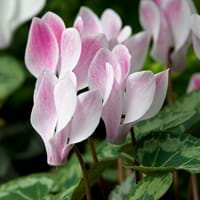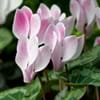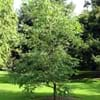Life Span
Perennial
Perennial
Type
Flowering Plants, Tubers
Flowering Plants, Shrubs
Origin
Europe, Mediterranean Basin, Middle East, North Africa, Somalia
Hybrid origin
Types
Cyclamen Africanum, Cyclamen Alpinum, Cyclamen Cilicium, Cyclamen Coum
Bigleaf hydrangea, Hortensia, Smooth hydrangea, Oakleaf hydrangea, Annabelle
Habitat
Alpine Meadows, Rocky areas, Woods
Forest edges, Hillside, Woods
USDA Hardiness Zone
5-9
4-9
Sunset Zone
15, 16, 17, 18, 19, 20, 21, 22, 23, 24
21,22
Habit
Clump-Forming
Clump-Forming
Flower Color
Pink, Purple, White
Yellow green, Pink, Rose, Violet, Plum
Flower Color Modifier
Not Available
Bicolor
Fruit Color
Brown
Not Available
Leaf Color in Spring
Several shades of Green
Green, Light Green
Leaf Color in Summer
Not Available
Green
Leaf Color in Fall
Green, Silver
Green, Yellow green
Leaf Color in Winter
Green, Silver
Light Green
Leaf Shape
Heart-shaped
Oblovate
Plant Season
Autumn, Spring, Summer, Winter
Spring, Summer
Sunlight
Indirect sunlight
Full Sun, Partial Sun
Type of Soil
Clay, Sandy, Well drained
Clay, Loam, Sand
The pH of Soil
Acidic
Acidic, Neutral, Alkaline
Soil Drainage
Well drained
Average
Bloom Time
Autumn, Spring, Summer
Early Spring, Spring, Late Spring, Early Summer, Summer
Tolerances
Not Available
Pollution, Drought, Salt
Where to Plant?
Container, Ground, Pot
Container, Ground
How to Plant?
From bulbs, Seedlings
Seedlings, Stem Planting
Plant Maintenance
Medium
Medium
Watering Requirements
Do not water frequently, It cannot sustain wet-feet, Keep the ground moist but not water-logged, Prefer drip-irrigation instead of Over-head watering, Water when soil is dry
Not Available
In Summer
Lots of watering
Average Water
In Spring
Moderate
Moderate
In Winter
Average Water
Average Water
Soil pH
Acidic
Acidic, Neutral, Alkaline
Soil Type
Clay, Sandy, Well drained
Clay, Loam, Sand
Soil Drainage Capacity
Well drained
Average
Sun Exposure
Indirect sunlight
Full Sun, Partial Sun
Pruning
Cut or pinch the stems, Prune if you want to improve plant shape, Prune ocassionally, Prune to control growth, Prune when plant is dormant, Remove dead leaves, Remove dead or diseased plant parts
Remove damaged leaves, Remove dead branches, Remove dead leaves
Fertilizers
All-Purpose Liquid Fertilizer
All-Purpose Liquid Fertilizer
Pests and Diseases
Aphids, Botrytis Cinerea, Gray mold, Mice, Mites, Root weevil, Slugs, Snails, Squirrels
Red blotch
Plant Tolerance
Drought
Pollution, Drought, Salt
Flower Petal Number
Single
Single
Foliage Texture
Medium
Medium
Foliage Sheen
Matte
Matte
Attracts
Not Available
Hummingbirds
Allergy
Respiratory problems
Chest tightness, Diarrhea, Dizziness, Nausea, Vomiting
Aesthetic Uses
Showy Purposes
Not Available
Beauty Benefits
Not Available
Not Available
Edible Uses
Unknown
Not Available
Environmental Uses
Air purification
Air purification
Medicinal Uses
Digestive disorders, Menstrual Disorders
Fever, Kidney problems, Urinary tract problems
Part of Plant Used
Root, Stem
Flowers, Root
Other Uses
Showy Purposes, Used as an ointment
Not Available
Used As Indoor Plant
Yes
Not Available
Used As Outdoor Plant
Yes
Yes
Garden Design
Not Available
Container, Foundation, Mixed Border
Botanical Name
Cyclamen Persicum
HEMEROCALLIS 'Rosy Returns'
Common Name
Cyclamen or Florist's Cyclamen
Daylily, Rosy Returns Daylily
In Hindi
Sikalemen
Hydrangea
In German
Zyklamen
Hortensie
In French
Cyclamen
Hortensia
In Spanish
Ciclamen
Hortensia
In Greek
κυκλάμινο
υδραγεία
In Portuguese
Cíclame
Hortênsia
In Polish
Cyklamen
Hortensja
In Latin
Cyclamīnos
Hibiscus
Phylum
Anthophyta
Not Available
Class
Dicotyledonae
Not Available
Order
Ericales
Not Available
Family
Primulaceae
Liliaceae
Genus
Cyclamen
Not Available
Clade
Not Available
Not Available
Tribe
Cyclamineae
Not Available
Subfamily
Myrsinoideae
Not Available
Number of Species
Not Available
Season and Care of Cyclamen and Rosy Returns Daylily
Season and care of Cyclamen and Rosy Returns Daylily is important to know. While considering everything about Cyclamen and Rosy Returns Daylily Care, growing season is an essential factor. Cyclamen season is Autumn, Spring, Summer and Winter and Rosy Returns Daylily season is Autumn, Spring, Summer and Winter. The type of soil for Cyclamen is Clay, Sandy, Well drained and for Rosy Returns Daylily is Clay, Loam, Sand while the PH of soil for Cyclamen is Acidic and for Rosy Returns Daylily is Acidic, Neutral, Alkaline.
Cyclamen and Rosy Returns Daylily Physical Information
Cyclamen and Rosy Returns Daylily physical information is very important for comparison. Cyclamen height is 0.54 cm and width 0.75 cm whereas Rosy Returns Daylily height is 25.40 cm and width 30.50 cm. The color specification of Cyclamen and Rosy Returns Daylily are as follows:
Cyclamen flower color: Pink, Purple and White
Cyclamen leaf color: Several shades of Green
Rosy Returns Daylily flower color: Yellow green, Pink, Rose, Violet and Plum
- Rosy Returns Daylily leaf color: Green and Light Green
Care of Cyclamen and Rosy Returns Daylily
Care of Cyclamen and Rosy Returns Daylily include pruning, fertilizers, watering etc. Cyclamen pruning is done Cut or pinch the stems, Prune if you want to improve plant shape, Prune ocassionally, Prune to control growth, Prune when plant is dormant, Remove dead leaves and Remove dead or diseased plant parts and Rosy Returns Daylily pruning is done Remove damaged leaves, Remove dead branches and Remove dead leaves. In summer Cyclamen needs Lots of watering and in winter, it needs Average Water. Whereas, in summer Rosy Returns Daylily needs Average Water and in winter, it needs Average Water.





